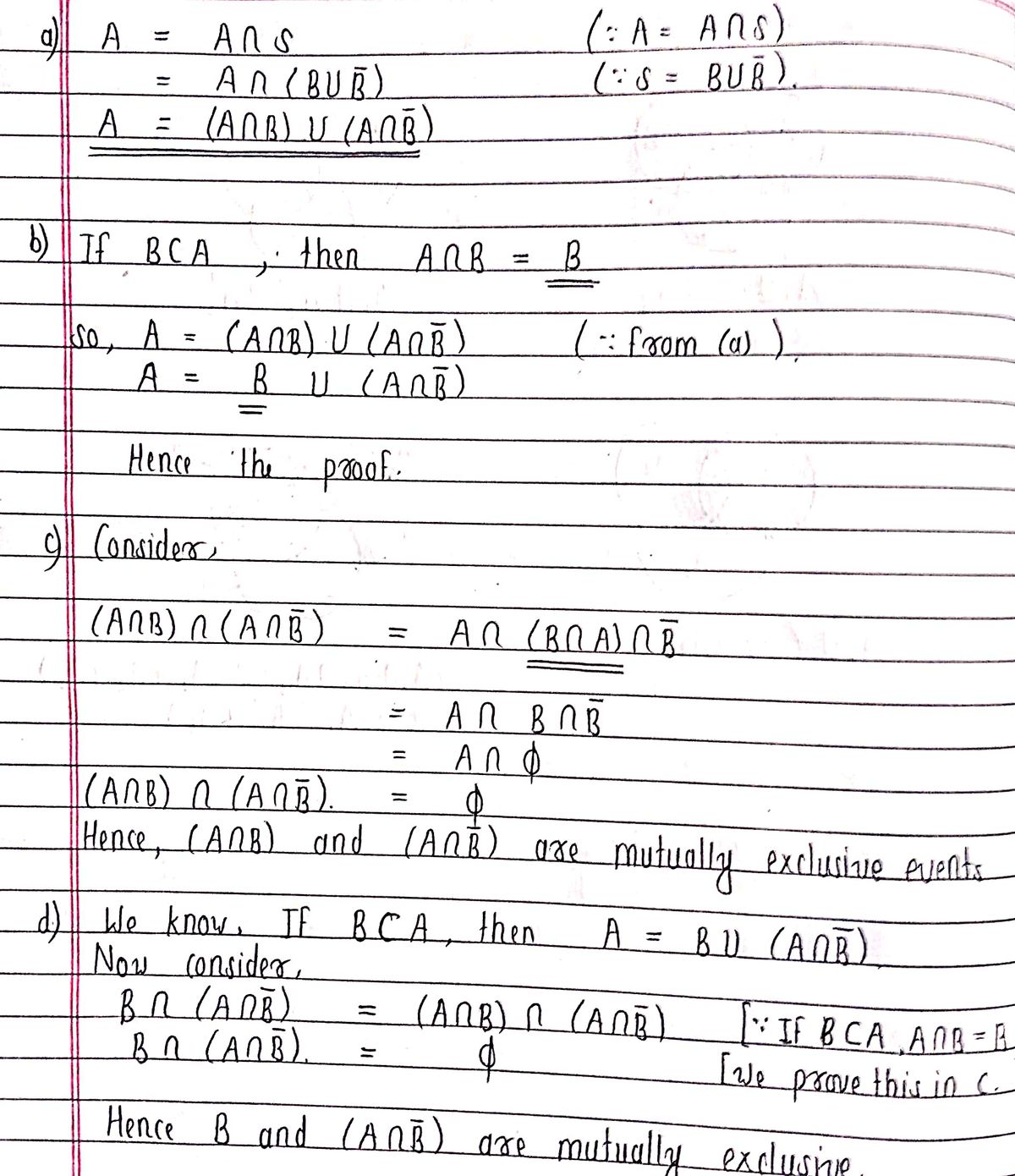Use the identities A = ANS and S = BUB and a distributive law to prove the following. (a) A = (ANB) U (ANĒ) A = AN--Select- V = AC --Select-- v UB = ---Select-- VU(AN B) (b) If BCAthen A = BU (AN B). From part (a), A = (AN B) U (A N B). If BCA, then ANB = --Select-- v, so A = -Select-- vU (AN B). (c) Further, show that (AN B) and (AN B) are mutually exclusive and therefore that A is the union of two mutually exclusive sets, (A N B) and (A N B). (AN B) n (AN B) = An(-Select--- vnB) =-Select-- v. Thus the two sets are mutually exclusive, and from part (a), A is the union of these two mutually exclusive sets. (d) Also show that B and (A N B) are mutually exclusive and if BCA, A is the union of two mutually exclusive sets, B and (AN B). Bn (ANĒ) = A n ---Select-- v nB) = ---Select--- v. Thus the two sets are mutually exclusive, and from part (b), A is the union of these two mutually exclusive sets.
Use the identities A = ANS and S = BUB and a distributive law to prove the following. (a) A = (ANB) U (ANĒ) A = AN--Select- V = AC --Select-- v UB = ---Select-- VU(AN B) (b) If BCAthen A = BU (AN B). From part (a), A = (AN B) U (A N B). If BCA, then ANB = --Select-- v, so A = -Select-- vU (AN B). (c) Further, show that (AN B) and (AN B) are mutually exclusive and therefore that A is the union of two mutually exclusive sets, (A N B) and (A N B). (AN B) n (AN B) = An(-Select--- vnB) =-Select-- v. Thus the two sets are mutually exclusive, and from part (a), A is the union of these two mutually exclusive sets. (d) Also show that B and (A N B) are mutually exclusive and if BCA, A is the union of two mutually exclusive sets, B and (AN B). Bn (ANĒ) = A n ---Select-- v nB) = ---Select--- v. Thus the two sets are mutually exclusive, and from part (b), A is the union of these two mutually exclusive sets.
A First Course in Probability (10th Edition)
10th Edition
ISBN:9780134753119
Author:Sheldon Ross
Publisher:Sheldon Ross
Chapter1: Combinatorial Analysis
Section: Chapter Questions
Problem 1.1P: a. How many different 7-place license plates are possible if the first 2 places are for letters and...
Related questions
Question

Transcribed Image Text:Use the identities A = ANS and S = BUB and a distributive law to prove the following.
(a) A = (ANB) U (ANĒ)
A = AN--Select- V
= AC
--Select-- v UB
= ---Select-- VU(AN B)
(b) If BCAthen A = BU (AN B).
From part (a), A = (AN B) U (A N B). If BCA, then ANB = --Select-- v, so A = -Select-- vU (AN B).
(c) Further, show that (AN B) and (AN B) are mutually exclusive and therefore that A is the union of two mutually exclusive sets, (A N B) and (A N B).
(AN B) n (AN B) = An(-Select--- vnB) =-Select-- v. Thus the two sets are mutually exclusive, and from part (a), A is the union of these two mutually exclusive sets.
(d) Also show that B and (A N B) are mutually exclusive and if BCA, A is the union of two mutually exclusive sets, B and (AN B).
Bn (ANĒ) = A n
---Select-- v nB) = ---Select--- v. Thus the two sets are mutually exclusive, and from part (b), A is the union of these two mutually exclusive sets.
Expert Solution
Step 1

Trending now
This is a popular solution!
Step by step
Solved in 2 steps with 1 images

Recommended textbooks for you

A First Course in Probability (10th Edition)
Probability
ISBN:
9780134753119
Author:
Sheldon Ross
Publisher:
PEARSON


A First Course in Probability (10th Edition)
Probability
ISBN:
9780134753119
Author:
Sheldon Ross
Publisher:
PEARSON
